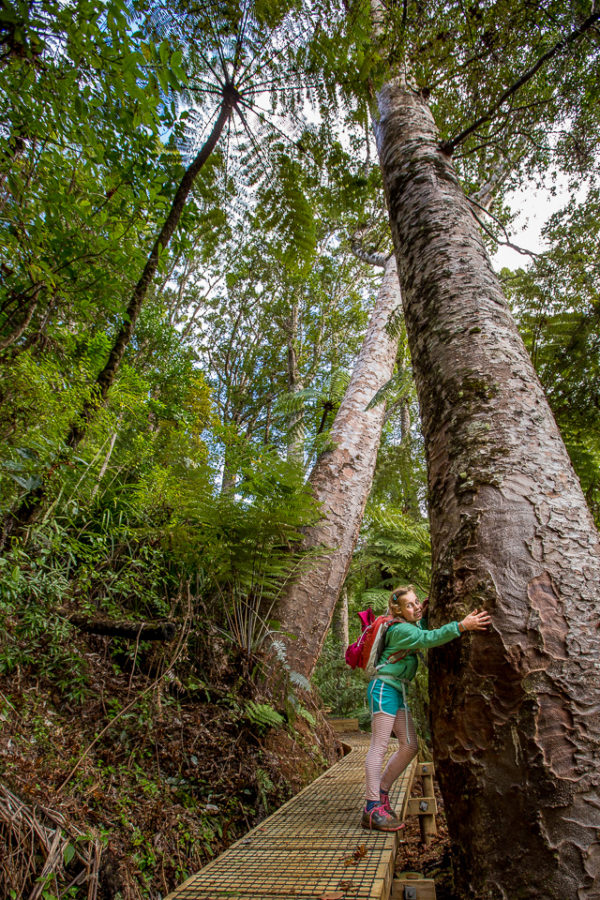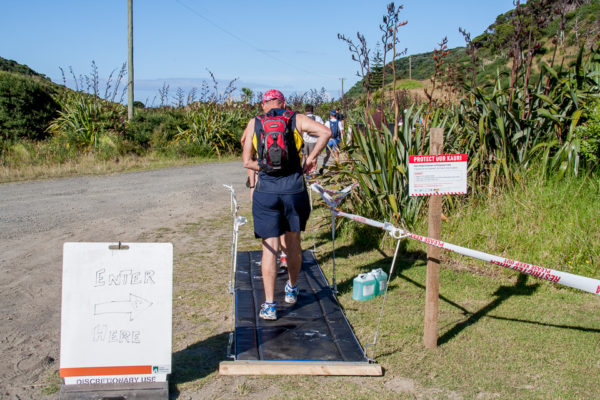We continue to work with the Auckland Council to ensure that we mitigate the risk of the event spreading Kauri Dieback. Through these measures and education of participants and supporters we ensure that we are using best practice to minimise the risk of spreading the disease that is affecting New Zealand’s greatest and most majestic native trees.
Information below provided from www.kauridieback.co.nz

WHAT ARE KAURI TREES?
Kauri giants
The New Zealand kauri is the largest tree in the Agathis genus and the only Agathis species native to New Zealand.
Many of the great kauri giants were felled by early pioneers for their high quality timber. One of the largest kauri trees ever recorded was ‘Kairaru of Tutamoe’ with an estimated diameter of 6.4m and a height of 65m. Unfortunately, Kairaru was destroyed in a fire before 1900.
The largest kauri alive today is Tane Mahuta with a diameter of 4.6m and height of 52m. It is estimated to be between 1200 and 2000 years old.
The creation myth
In the beginning, out of nothingness Ranginui (the sky father) and Papatuanuku (the earth mother) were created. Rangi and Papa clung together, trapping the children they had made in a land of darkness. The strongest child Tane mahuta (the god of the forests and creator of the forest creatures) pushed his parents apart to bring light to the land and allow his children to flourish. The Te Roroa iwi of Waipoua forest believe Tane’s legs were the giant trunks of kauri.
Cultural significance
Kauri is considered a taonga species by many Māori: valued as a connection to the spiritual beliefs and way of life of their ancestors.
Kauri played an important role in many aspects of early Māori culture: integrated in creation mythology, rituals, war, art and everyday life. Some large trees were given names and revered as chiefs of the forest. On special occasions, the giant trunks of kauri were used to carve out large waka taua (sea/war canoes)
Kauri gum had many valuable functions. Gum was burned as an insecticide in kumara plots, wrapped in flax to make torches for night-fishing and used as a chewing gum (kapia). Kauri resin was also burnt and mixed with fat to create the ink for moko (facial tattooing) of rangatira.
By the 1800s, early European pioneers had developed a thriving timber and gum industry based on kauri. Large areas of kauri were felled for their timber, which was valued for its strength and ability to withstand sea-water conditions (ideal for boat masts and hulls).
Kauri gum was used in varnishes, paint, linoleum and to create ornaments. Gum was largely collected from the ground, however some was gathered by deliberately injuring or ‘bleeding’ trees.
Our taonga -“Kauri are one of the largest rainforest trees on earth and they are to New Zealand what the pyramids are to Egypt and Stonehenge and cathedrals are to England,” Stephen King, Northland
WHAT IS KAURI DIEBACK?
Kauri dieback is the deadly kauri disease caused by Phytophthora taxon Agathis (or PTA). Following DNA studies, this fungus-like disease was formally identified in 2008 as a distinct and previously undescribed species of Phytophthora. Kauri dieback is specific to New Zealand kauri and can kill trees of all ages.
HOW DOES IT SPREAD?
Microscopic spores in the soil infect kauri roots and damage the tissues that carry nutrients within the tree.
Kauri dieback life cycle
The oospores are like the ‘seeds’ of this disease, with a hard outer shell they can sit dormant in soil for up to three years or more. These spores live in soil and are spread with soil movement. Dirty footwear, animals, equipment and vehicles are responsible for the large scale spread of this disease – between different areas of kauri.
The introduction of spores to an area of kauri can lead to a new area of infection. We don’t yet know what “inoculum load”/number of spores are required for an infection to occur – however, as the spores can reproduce/multiply once introduced to an area, a minute amount of soil with a tiny amount of spores can result in a new area of disease.
WHAT DOES IT DO TO KAURI TREES?
Microscopic spores in the soil infect kauri roots and damage the tissues that carry nutrients within the tree. Infected trees show a range of symptoms including yellowing of foliage, loss of leaves, canopy thinning, dead branches and lesions that bleed gum at the base of the trunk.
Some infected trees can show canopy dieback and even be killed without any gum showing on the trunks as kauri dieback also acts as a severe root rot below ground.
Nearly all infected kauri die. In the past 10 years, kauri dieback has killed thousands of kauri in New Zealand.
Scientists are currently working to find control tools for this disease but there is no known treatment at this time.
PREVENTION – What can I do to save our kauri forests?
Without any treatment or control tools, the only way we can save our kauri forests is to contain the disease in its current locations and stop the spread into healthy areas
When you are around kauri:
- Make sure shoes, tyres and equipment are cleaned to remove all visible soil and plant material before AND after visiting kauri forest
- Please use cleaning stations installed on major tracks: scrub to remove all soil and spray with disinfectant.
- Stay on the track and off kauri roots
- Keep your dog on a leash at all times.
We all can help – tourists, hunters, trappers, trampers, runners, bikers, walkers. We all need to make it happen, rather than hope ‘someone else’ will do it.
Read more here on how to stop the spread (170.6 KB PDF).
WHAT ARE WE DOING FOR THE EVENT?
As taken from the event permit from Auckland Council:

- That to minimise the risk of any further spread of Kauri Dieback Disease the following phytosanitary and hygiene standards are to be implemented by Lactic Turkey Events;
- Include as a “rule of the event’ (which is iterated at the pre-event briefing) that all participants shall undertake phytosanitary measures, keep to the route and tracks at all times and that tracks are taped , at critical sites to be identified by the Principal Ranger, or his nominee to ensure no off track activity in bush blocks.
- Track surface and condition assessments will be carried out within the 5 recognised Kauri Dieback disease zones, plus a 30m buffer each side, in the 7 days prior to the event especially if there has been sustained wet periods or extreme weather events. If track conditions are found to have high soil\mud\water contamination potential during the event, extra phyto-sanitary provisions shall be incorporated and required to be used by the participants together with the provision of extra brushes.
- Undertake best endeavours to advise all event participants that footwear and clothing must be clean 1 prior to the event starting, and that footwear must also be cleaned at the completion of event (on site or at home).
- Ensure that materials and facilities provided for participants, supporters and event staff to clean footwear to a suitable hygiene level are used in the appropriate manner.
- Phytosanitary tray and mat style foot washing stations will be located at key locations
- Lactic Turkey Events is responsible and must ensure the use and management of the phytosanitary (tray & mat) footwashing stations complies with the required standards’ “Hygiene Procedures for Kauri Dieback and “Guidelines for Footwear Cleaning Kit”.
- Crate style foot washing stations with spray bottles of Trigene and fixed footwear brushes will also be located at positions on the course and must be used by all.
So in summary for all participants, supporters and volunteers
- Please wash all footwear before the event
- Please use ALL footwashing stations you see in your travels throughout the day at the event
- Please stay to the formed tracks at all times
- Please stay off Kauri roots
- Please no dogs during the event
- Please wash all footwear after the event


